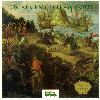
| Dan Bunten |
| Bill Bunten |
| Jim Rushing |
| Alan Watson |
Patch for a d64 disk image:
| $152d8 | $04 -> $00 |
| $152d9 | $b8 -> $5f |
| $152da | $07 -> $0d |
| $152db | $85 -> $ff |
Dani Bunten on The Seven Cities of Gold:
"Seven Cities of Gold" was my best selling
game. It garnered a SPA Gold Disk and a number of minor awards. It was also my first game
that didn't allow for more than one player. It was planned to be multi-player but during
development it lost that aspect, along with colonists and development. To keep it's
focus (and allow for a really large world) it ended up just covering the early exploration
and conquest of the new world. It was published in '84 by Electronic Arts and it was the
game Trip Hawkins (founder of EA) coined the term "edu-tainment" to describe on
the press tour introducing it. (Back then the term wasn't the kiss of death it is now).
There are several things I'm proud of about that game.
Unlike most strategy-adventure games then (and now as well) which load the player with
numerous economic and logistical decisions, it only used four commodities to model the
constraints and opportunities facing the Conquistadors (men, food, [trade] goods and
gold). I also like the way I was able to reflect the unique interactions between natives
and Conquistadors when they shared neither a language nor cultural values in common. I
came up with a simple arcade element which also included a number of subtle
"secret" opportunities that I was quite gratified to learn that folks found on
their own. Finally, the fact that our "New World" was randomly generated (and so
large it required disk caching and overlays) made exploring a challenge fraught with peril
and surprises. It sufficiently captured the sense of panic that comes from being lost in
the wilderness and running out of supplies as well as the joy of rescue (which was
something I experienced once backpacking and wanted to make a touchstone of this design).
Our biggest frustration with this product was that it was
developed in the days when you had to write a number of different versions since no
platform was pre-eminent. There were Atari 800, C64, Apple, Mac and IBM PC versions of the
game put out but the only "full" version was on the Atari. On the others we did
the best we could with what we had.